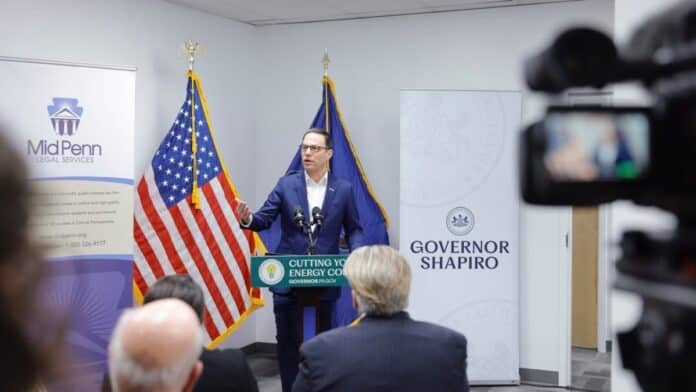Governor Josh Shapiro has introduced his $51 billion budget plan for 2025-26, which addresses major issues such as education, public safety, transportation, and workforce development.
At the same time, the proposal includes plans to generate new revenue by legalizing marijuana and regulating skill games.
However, with the state’s revenue growth slowing and federal COVID relief funds running out, Pennsylvania faces mounting pressure to balance its finances.
To begin with, education takes center stage in Shapiro’s budget.
The proposal includes $526 million in new funding for K-12 public schools, with an emphasis on directing money to underfunded districts.
Additionally, special education funding is set to increase by $40 million, bringing the total to over $1.5 billion.
Also, Shapiro plans to double funding for student-teacher stipends, raising it to $40 million and allocating $5.5 million for career and technical education programs to address the state’s teacher shortage.
Beyond academics, the Governor also proposes $100 million for school mental health and safety initiatives, continuing investments in universal free breakfast for all 1.7 million students, and $3 million to keep menstrual hygiene products free in schools.
Regarding workforce development, Shapiro’s budget offers practical solutions to ongoing labor shortages.
For instance, it includes $12.5 million for training programs to help workers gain new skills and $6 million for adult literacy centers to help people earn their GEDs.
These investments are expected to assist thousands of Pennsylvanians currently on waitlists.
Furthermore, the Governor has proposed $55 million in recruitment and retention bonuses for childcare workers and an additional $15 million to raise wages for pre-K educators.
The budget also sets aside $21 million to boost wages and benefits for direct care workers assisting seniors and individuals with disabilities.
In terms of mental health, the Governor is proposing several important measures.
First, the budget sets aside $100 million for school-based mental health services and $20 million for county mental health programs.
Moreover, $10 million will go toward the 9-8-8 crisis hotline network, and $5 million will fund mental health crisis centers.
The plan also adds $10 million to expand loan forgiveness programs for workers in underserved areas, encouraging more professionals to enter the behavioral health field.
One of the more debated parts of the budget is the legalization of adult-use marijuana.
By 2026, this move is expected to generate $500 million in revenue annually.
The funds would support initiatives like helping small businesses enter the cannabis industry and expunging records for minor marijuana-related offenses.
At the same time, the Governor is proposing regulations for skill games, which are currently widespread but unregulated.
By bringing them under the oversight of the Gaming Control Board, this measure could generate $99 billion over five years, with some of the funds directed to senior programs that have lost lottery funding due to competition from skill games.
Shapiro’s budget builds on recent successes in repairing roads and bridges by shifting to transportation and infrastructure.
Specifically, it proposes $292.5 million in additional funding for public transit systems and continues a plan to free up $750 million over five years for road and bridge repairs by reducing State Police reliance on the Motor License Fund.
These changes aim to maximize federal infrastructure funding and improve travel conditions across the state.
On the topic of public safety, the Governor’s plan includes funding for four new State Police cadet classes and $10 million to expand violence prevention programs.
Another $30 million will help fire departments purchase equipment, recruit staff, and prepare for emergencies.
Importantly, the budget also allows emergency funds to be used for projects that prevent disasters, such as flooding, rather than just responding to them after they occur.
Housing affordability, another pressing issue, receives significant attention in this budget.
The proposal offers over $1 billion in property tax relief, saving the average homeowner $160.
Additionally, $50 million is set aside for home repairs, $10 million will help first-time homebuyers with closing costs, and $10 million will go to building affordable housing through the PA Housing Affordability and Rehabilitation Enhancement Fund.
Turning to health care, the budget provides $10 million to support rural hospitals and another $10 million to address broader hospital challenges across the state.
An additional $5 million is allocated for research into diseases like Alzheimer’s and ALS, building on Pennsylvania’s reputation as a leader in medical research.
In maternal health, Shapiro plans to improve postpartum care by implementing universal screenings for new mothers and increasing access to mental health resources for those experiencing postpartum depression.
Energy and environmental sustainability are other areas in which the governor hopes to make progress.
Shapiro’s “Lightning Plan” includes measures to expedite the development of clean energy projects while generating $11.4 billion in new investments, aiming to reduce energy costs by $664 million for Pennsylvanians by 2040.
The Governor is also looking to modernize the state’s energy efficiency standards and update programs like Act 129, which incentivizes the purchase of energy-efficient appliances.
Despite its ambitious goals, the budget acknowledges the financial challenges facing the state.
Revenue growth has slowed, and federal pandemic relief funds that once bolstered the state’s finances are nearly exhausted.
Proposed revenue sources, such as marijuana legalization and skill game regulation, could help bridge the gap, but they are uncertain.
For example, while marijuana sales could generate significant income, the actual returns depend on how quickly the industry is implemented and how much revenue it attracts.
Finally, the budget includes plans to close Rockview State Prison and Quehanna Boot Camp as the state’s prison population continues to shrink.
These closures could save over $100 million a year, but they have sparked criticism from the union representing prison staff, which warns of potential safety concerns and overcrowding elsewhere.
Overall, while Governor Shapiro’s proposal faces challenges in revenue and implementation, the plan lays out a clear vision for Pennsylvania’s future and provides a strong foundation for legislative discussions in the months ahead.





